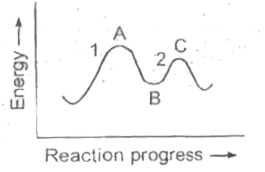When a reaction is progressing.
The rate of the reaction goes on increasing
The concentration of the products goes on decreasing
The concentration of the reactants goes on decreasing
The reaction rate always remains constant
The correct Answer is:C
To solve the question about the progression of a chemical reaction, let's analyze the situation step by step.
1. Understanding the Reaction:
- Let's consider a hypothetical reaction where reactants A and B are converting into products C and D.
- The general form can be represented as:
A+B→C+D
2. Observation of Concentrations:
- Initially, we have certain concentrations of reactants A and B.
- As the reaction progresses, the concentrations of the reactants will change, and products will start to form.
3. Change in Concentration:
- As the reaction proceeds, the concentration of reactants A and B will decrease because they are being consumed to form products C and D.
- Conversely, the concentration of products C and D will increase as they are formed from the reactants.
4. Rate of Reaction:
- The rate of a reaction is generally dependent on the concentration of the reactants.
- According to the rate law, the rate of reaction can be expressed as:
Rate=k(A)m(B)n
- Here, k is the rate constant, and m and n are the orders of the reaction with respect to reactants A and B.
5. Evaluating the Options:
- Option 1: The rate of the reaction goes on increasing.
- This is incorrect because as the concentration of reactants decreases, the rate of reaction will also decrease.
- Option 2: The concentration of the product goes on decreasing.
- This is incorrect because the concentration of products increases as the reaction progresses.
- Option 3: The concentration of reactants goes on decreasing.
- This is correct because the reactants are being consumed in the reaction.
- Option 4: The reaction rate always remains constant.
- This is incorrect because the rate of reaction changes with the concentration of reactants.
6. Conclusion:
- The only correct statement is that the concentration of reactants goes on decreasing as the reaction progresses.
Final Answer:
The correct option is that the concentration of reactants goes on decreasing.
- Let's consider a hypothetical reaction where reactants A and B are converting into products C and D.
- The general form can be represented as:
A+B→C+D
- Initially, we have certain concentrations of reactants A and B.
- As the reaction progresses, the concentrations of the reactants will change, and products will start to form.
- As the reaction proceeds, the concentration of reactants A and B will decrease because they are being consumed to form products C and D.
- Conversely, the concentration of products C and D will increase as they are formed from the reactants.
- The rate of a reaction is generally dependent on the concentration of the reactants.
- According to the rate law, the rate of reaction can be expressed as:
Rate=k(A)m(B)n
- Here, k is the rate constant, and m and n are the orders of the reaction with respect to reactants A and B.
- Option 1: The rate of the reaction goes on increasing.
- This is incorrect because as the concentration of reactants decreases, the rate of reaction will also decrease.
- Option 2: The concentration of the product goes on decreasing.
- This is incorrect because the concentration of products increases as the reaction progresses.
- Option 3: The concentration of reactants goes on decreasing.
- This is correct because the reactants are being consumed in the reaction.
- Option 4: The reaction rate always remains constant.
- This is incorrect because the rate of reaction changes with the concentration of reactants.
- The only correct statement is that the concentration of reactants goes on decreasing as the reaction progresses.
The correct option is that the concentration of reactants goes on decreasing.
Similar Questions
Knowledge Check
When a reaction progresses, _____.
Athe rate of the reaction goes on increasingBthe concentration of the products goes on decreasingCthe concentration of the reactants goes on decreasingDthe reaction rate always reamins constantFollowing graph between ΔG and reaction progress in for/can be :
 ASN1 reactionBE1 reactionCAromatic electrophilic substitutionDElectrophilic addition reaction
ASN1 reactionBE1 reactionCAromatic electrophilic substitutionDElectrophilic addition reaction
Reaction progress →AIt is a 2 steps reaction , step 1 is slower than step 2BIt is a 2 steps reaction , step 2 is slower than step 1CSingle step reaction where B is a activated complexDSingle step reaction where B is a reaction intermediate
Harmonaic Progression
View SolutionProgressive
View SolutionWhen a simple harmonic progressive wave is propogating the medium, all the particles of the medium vibrate with
View SolutionWhen a simple harmonic progressive wave travels through the medium, the relation between phase difference and path difference is
View SolutionThe oxidation of oxalic acid by acidified KMnO4 becomes fast as the reaction progresses due to :
View Solution
